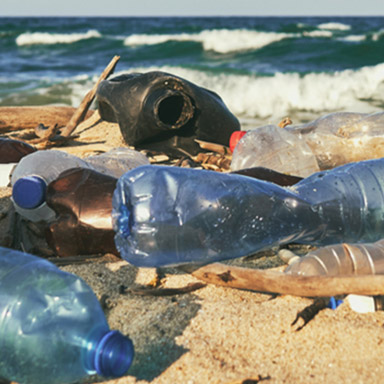

Microplastics – unpredictable micro particles for humans and nature
The topic of plastics and the resulting problem of disposal has been addressed in public almost every day during the last years. Pictures of coastal areas which suffocate in empty plastic bottles, bags and other throw-away packages are being flushed into media. But what does the term microplastics really mean? In this blog post we shed some light on the matter.
Plastics: relatively new but made for eternity
Appallingly, plastics are part of industrial manufacturing for not more than 70 years. Because these materials which mainly consist of derivates from petro chemicals or polymeres offer a long resistance and high stability of shape, they are popular for many different applications. But this also determines their difficulty. Some sorts of plastics, for example used for bottles, need several centuries to vanish and therefore give testimony in a scaring and harmful way of our civilization. Furthermore, it is nowadays often brought into context that the materials can release small particles – known as microplastics – which can appear again at different places.
What exactly are microplastics? What does it have to do with cosmetics?
The term microplastics is coined to describe small pieces of plastics with a diameter less than 5 mm. Basically, they exist in two forms: First, as the result of plastic products which are degraded by weathering processes such as water and UV rays. Secondly, such micro particles can be deliberately produced, amongst others to be used in conventional cosmetics. For example, peeling creams which should have an abrasive effect are often supplied with plastic micro particles.
Alternatives for care products: certified natural cosmetics
Since the impact of microplastics on the human organism has not yet been sufficiently investigated, consumers get more and more sceptical and deliberately avoid those products affected. A possible way: choose certified natural cosmetics, because the guidelines do not allow the use of microplastics. To pick up those peeling creams again: Instead of plastic particles e.g. cellulose materials are being used which rub off the skin softly and are way more eco-friendly.
Microplastics have far-reaching effects
Not only on our skin we like to avoid plastics. Since the skin is our biggest sense organ, we should bear in mind to check with what kind of substances we bring it together. By now, several studies have revealed that small micro particles of plastics settle at different parts of the human organism. That also opens the gates for the local sewage treatment plants. From here the materials find their ways to rivers and oceans and finally as harmful sources of food for the animals living in there. It is high time to change one’s consumer behaviour for a change concerning plastics! Each deliberate purchase decision has the potential to make a fair change!
12. November 2018
